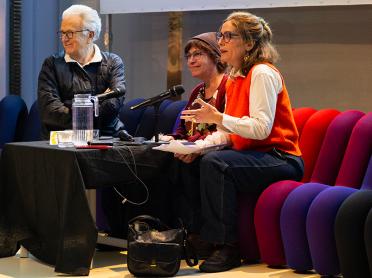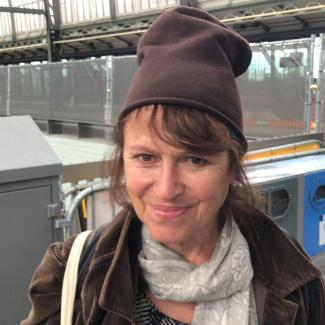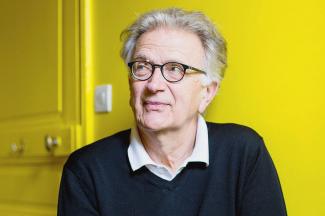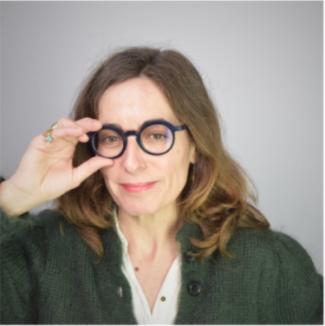Plan and cut with Patricia Mazuy and Patrick Bouchain
Monday 17 Nov 2025 from 7pm to 8:30pm
Free on booking
Talk in french

What role does architecture play in cinema? Can cinema conceive of architecture? By bringing together architects and filmmakers with shared interests for a dialogue, this series of meetings, conceived and hosted by Isabelle Regnier, a journalist at Le Monde, aims to break down the barriers that tend to separate disciplines in order to explore new perspectives and new ways of seeing.
This second evening brings together filmmaker Patricia Mazuy, a unique figure in French cinema, and Patrick Bouchain, an architect and scenographer known for his committed and participatory approach to architecture.
Since the late 1980s, Patricia Mazuy has made a number of notable films, including Peaux de vaches (1989), Saint-Cyr (2000) and, more recently, Bowling Saturne (2022). Her films explore power relations, contained violence and the quest for emancipation. The strangeness of the world and the darkness of souls are infused with all the more harshness as her staging is rooted in the materiality of contemporary landscapes and mundane architecture.
Architect, urban planner and scenographer, Patrick Bouchain has carried out numerous flagship projects in the contemporary cultural scene, such as the Lieu Unique in Nantes, the Condition Publique in Roubaix and the Zingaro equestrian theatre in Aubervilliers, which testify to his undiminished passion for theatre and the performing arts. A pioneer in the conversion of industrial sites into cultural venues, this free spirit – who is also a film buff – has always refused to join the Order of Architects. He advocates for a collaborative approach to architecture (with residents, workers, architects, etc.), regularly collaborates with artists, and champions the idea of ‘doing things differently’ in the face of the stifling power of convention.
Patricia Mazuy wanted to attend the Louis Lumière film school, but enrolled at HEC business school instead. She spent most of her time at the film club, where she confirmed her love of westerns and crime films, discovered The Doors (who were already dead by then), and left school for Los Angeles. There, she made a short film with her babysitting earnings and met Agnès Varda and her editor Sabine Mamou. Three years later, Mamou hired her as an intern on Une chambre en ville, and she finally learned her craft. After editing Sans toit ni loi, she devoted herself to her first film, Peaux de vaches. She had begun writing in 1983 for Jean-François Stévenin, whose Passe montagne she admired.
He has collaborated with numerous artists, including Daniel Buren, Sarkis, and Bartabas. As an architect, his notable works include: the design of the Le Magasin cultural centre in Grenoble (1985), the Théâtre Zingaro in Aubervilliers (1988), Le Lieu Unique in Nantes (2000) in the former LU factories, the International Museum of Modest Arts in Sète (2000), the Académie Fratellini in Saint-Denis (2002), the conversion of La Condition Publique in Roubaix (2003) and Le Channel, Scène Nationale de Calais (2005) in the former slaughterhouses.
A pioneer in the redevelopment of industrial sites into cultural spaces, he has focused his work on the performing arts, mobility and the ephemeral. Fundamentally non-conformist, he practises HQH (Haute Qualité Humaine, or High Human Quality) architecture with the Construire agency (founded with Loïc Julienne and Nicole Condorcet), developing construction sites that are open to the public, true cultural events, with a constant questioning of standards. Since 2009, he has focused his work on applying these experiences to propose alternative ways of producing social housing through a project entitled ‘Le Grand Ensemble’ in several cities: Boulogne-sur-Mer, Tourcoing and Beaumont.
Patrick Bouchain has always considered transmission to be an integral part of his practice. In 2010, he created the ‘l'université foraine’ (fairground university), which aims to train students and elected officials to carry out constructive operations off the beaten track. In 2018, he set up ‘La Preuve par 7’ to develop projects on sites of various scales: a village, a town, a city, a suburb, a metropolis... He received the Grand Prix de l'Urbanisme in 2019.
Her career as a journalist began in 2000 after a period spent working for cultural institutions in New York and then Hong Kong. She first worked for the magazine Les Cahiers du cinéma, where she covered the economics of cinema and cultural policy (under the pseudonym Anne Ballylinch). She then joined the editorial staff of Le Monde in 2002. After fifteen years as a critic in the cinema section, she was given responsibility for the newspaper's architecture and heritage section. Isabelle Regnier is the author of two documentaries, La Rue est à eux (2010) and Pièce Montée (2012). Winner of the Prix de la critique de l'Académie d'architecture in 2019, she has contributed to several books: Jacques Rozier, le Funambule (Cahiers du cinéma, 2001), Elles construisent, portraits d'architectes franciliennes (Maison de l'architecture d'Ile-de-France, 2024), La Fondation danoise: Kaj Gottlob (Still, 2025). She also teaches as part of the Arts master's programme at the Ecole Nationale Supérieure and the cultural journalism master's programme at the Sorbonne Nouvelle.


